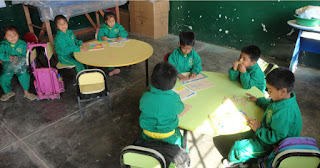Often when Maribel and I are walking on one
of Chiclayo’s busy streets one of us will look at the other and ask,”What’s the
name of the game?” The other will answer…”Transportation.”
In another land in the age of long ago I
had a friend who drove truck for a living. He was fond of saying, “If you’ve
got it, a truck brought it.” He was right of course, and I assume that that
phrase is true in Peru as well, though the big semi-trailer rigs and huge truck
terminals aren’t nearly as prominent in Chiclayo as I recall them being in the
USA. But it’s not the transportation of goods that prompts our ‘name of the
game’ exchange. It’s the ubiquitous
sights and sounds of people transportation that draws our attention.
Taxies, combis and mototaxies absolutely
dominate Chiclayo’s streets morning, noon and night. They are not passive in
seeking your business. Each of the three has their own method of getting in
your face. Combis are the most aggressive. They stop at irregular intervals
where the cobrador (the guy who collects the money) gets out and literally
shouts their next destination to passersby, and if you even glance at him or
the combi he may grab you by the arm and try to steer you to a seat on board,
whether you want to go or not. And in between stops the driver is not hesitant
to use his horn to get your attention. It is a highly competitive business; there
are only minutes and frequently seconds separating the combis. It is not
unusual to see a potential passenger with each arm being held by a different cobrador
trying to guide the person to their combi.
Taxi drivers aren’t physically aggressive,
but they don’t take a back seat to combis when it comes to horn blowing. If
you’re a gringo walking the street, or if you have a package in your arms, or
if you stop for a second you’ll have a taxi blow his horn at you, as if to say,
“Hey…this is your lucky moment. I just happen to be available.” The 50 taxis
behind him also just happen to be available and each will blow his horn, even
though they have seen you ignore the first 50 and have given no indication that
you want a ride. I’ve never quite understood that.
Mototaxi drivers don’t blow their horns,
and they don’t scream at you. What they do is softly say, “Moto moto”…almost in
an inquisitive or apologetic tone. I don’t know why they say moto twice. Maybe
it’s because they say it softly and want to make sure you heard it.

Okay…let’s say that you’re fed up with your
high-pressure job on Wall Street and want to drive a mototaxi in Chiclayo. How
do you get started and what can you expect from your new occupation? First you
need to buy a moto. That will cost you between $1170 and $1270 depending on if
you want doors and a windshield. You could add colored lights and a radio with
CD player but that won’t bring you any additional business (Chiclayanos don’t
care about such things) and they will probably be stolen. Maintenance on your new moto amounts to
changing oil every 20 days, and occasionally replacing the plastic seat
material that passengers have a penchant for ripping, though not intentionally. You
don’t have to buy a moto…you can rent one for about $4.50 per day - about 30%
of your daily earnings which is why 80% of moto drivers own theirs.
On an average day you will earn between
$12.50 to $16 - that’s provided you work the normal 10 – 11 hours starting at
6:00 am. There are basically two strategies for operating your moto. You can
cruise the streets looking for business; those who advocate this method acknowledge
they use more gas but feel they expose themselves to more potential customers,
or you can base at a specific location, usually as a member of an association. Most
moto drivers take this last approach.
From your base location you will make about
25 trips per day, at an average fare of $0.57. You will transport from 1 to 3
people, but the fare is per trip, not per customer. The average distance you
will travel is about one-half mile, with two miles being the extreme limit. On some
of your return trips you will be hailed by another customer before you reach
your home base. Many customers will have groceries or other items to carry.
Moto drivers are agreeable to transporting a variety of items but most will
refuse metal, fearing damage to the interior, or animals.
If you ask any Chiclayo moto driver what his
biggest headache is, he will tell you it is competition. There are more motos
than passengers and often in the scramble for business the competition can turn
ugly. But there is a lighter side. One moto driver, when asked what his most
unusual customer request was, said that he was offered $3 by a man who wanted
to follow his wife whom he suspected of cheating on him. Think about it…that’s more excitement than
your Wall Street job offers, isn’t it?












